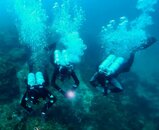My conclusion is that panic is the real killer, not the OOG situation. (I use the more generic term "Out Of Gas" instead of "Out of Air")
After a string of local OOG accidents at the beginning of this season I was curious how OOG really manifests itself. So, I closed the isolator valve on my AL80 doubles and breathed of the right tank like every recreational diver would breathe from a single AL80. I went down to 60' and swam around until I felt the breathing resistance increase. I dive Scubapro Mk17 first stages with G250V seconds, which are both balanced and give you less warning about low tank pressure than unbalanced regulators. When I felt the breathing resistance increase, I immediately started my ascent to 30' and stopped at 30' for 1 minute, slowly milking gas out of the regulator. Then I went up to 20', spent another minute there, then to 10' for another minute and finally, slowly to the surface. Since I deliberately took my time ascending I then needed to inflate the BCD/wing orally (which I survived too).
Please do not try this at home. Please understand that I had another gas source as a back up during this experiment (isolated left tank with its own regulator set). Do not use my story as a reason to skip proper gas planning or as an excuse for not monitoring your gas consumption during every dive. Running out of gas for real is stupid.
But if you ever run out of gas (unnecessary) without a buddy in sight (imprudent) do not panic. Get your rear end off the bottom FAST, spend as much time as possible in the shallows (above 50% of max depth) where you can suck more gas out of an "empty" tank, and don't hold your breath. Also, practice oral inflation of your BCD with surface air.
And PLEASE do not start another Spare Air thread.




